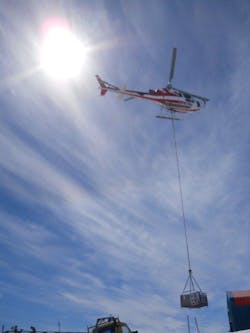SPECTROSCOPY: Femtosecond laser measures atmospheric-radical traces in Antarctica
A femtosecond laser was part of a recent successful study at a French Antarctic base to measure key trace molecular species—iodine monoxide (IO) and bromine monoxide (BrO)—at the parts per trillion per volume (pptv) level by optical absorption. The high reactivity of these free radicals means that they are only present at pptv concentrations at low altitude. However, this same high reactivity means they play a key role in atmospheric oxidation chemistry—even at this trace level.
To achieve the necessary sensitivity and precision, the team built a detection system based on a technique called modelocked cavity-enhanced absorption spectroscopy (ML-CEAS). First developed in 2002, this technique is similar to other CEAS methods such as ringdown spectroscopy in that the detection cell takes the form of a high-finesse cavity using superpolished mirrors with better than 99.99% reflectivity. (The use of such a resonant cavity delivers an effective path length of many kilometers.)
Simultaneous measurement of spectral lines
But unlike other CEAS techniques that rely on tunable narrowline lasers, ML-CEAS uses the broadband pulses of a femtosecond laser for multiplex detection over a wide spread of wavelengths. Spectral resolution is achieved by dispersing the cavity output using a grating spectrometer with integrated CCD detection. This enables simultaneous measurement of numerous spectral lines of IO and BrO as well as the bonus of an absorption band of nitrogen dioxide (NO2), another species with a key role in atmospheric chemistry.
These researchers chose a particular laser—the Chameleon Ultra II, made by Coherent (Santa Clara, CA)— for their work for several reasons. First, they believed that it was sufficiently rugged and reliable to operate out of the box after shipping to this harsh remote location. In particular, it performs over a very wide range of operating temperatures. It is also relatively immune to instability due to any feedback reflections that might occur from coupling the laser into the resonant detection cavity. In addition, the laser has a wider tuning range than other Ti:sapphire lasers; it can readily reach the relatively short 676 nm wavelength fundamental necessary for frequency-doubling to the 338 nm wavelength region where BrO strongly absorbs.
Icebreaker stranded twice
The project did not proceed without hitches, however. The measurements were to be made in a small laboratory at a French base on the Antarctic island of Dumont D’Urville in the austral summer period. Unfortunately, during shipping of the laser, the icebreaker delivery ship got stuck twice. The laser was then airlifted by a helicopter and then finally carried to its ultimate destination on a sled (see figure).
Problems for the researchers did not end with successful arrival of the laser and other system components. The MLCEAS technique places high demands on laser and system stability, requiring ultraprecise alignment of the laser with the measurement cavity and matching of the laser and cavity lengths for synchronous coupling. When the team started up all the equipment with the outer door closed, the temperature in the tiny lab quickly reached 40°C. Although the laser worked fine, the other system components could not handle this temperature; a decision was made to attempt to run the experiments with the lab door open, which lowered the lab temperature to 5°C. At this other temperature extreme, everything worked fine.
A full summary and an analysis of all the resultant data have not yet been published. However, the researchers have reported several preliminary findings including observations of IO during a snowstorm in which there was the presence of a strong katabatic wind from the continent (a katabatic wind is a gravitational wind produced by the weight of a cold air mass tumbling down a geographical relief). Specifically, no IO was observed during the actual time of snowfall, but could be clearly seen at other times. Nitrogen dioxide was also monitored, and showed a strong dependence on the wind direction with strong peaks occurring when the air mass was coming from
the direction of the station.
The work was directed and conducted by researchers from the Laboratoire Interdisciplinaire de Physique (LIPhy) in cooperation with scientists from the Laboratoire de Glaciologie et Geophysique de le’Environnement (LGGE; both in Saint Martin d’Hères, France).
About the Author
John Wallace
Senior Technical Editor (1998-2022)
John Wallace was with Laser Focus World for nearly 25 years, retiring in late June 2022. He obtained a bachelor's degree in mechanical engineering and physics at Rutgers University and a master's in optical engineering at the University of Rochester. Before becoming an editor, John worked as an engineer at RCA, Exxon, Eastman Kodak, and GCA Corporation.

